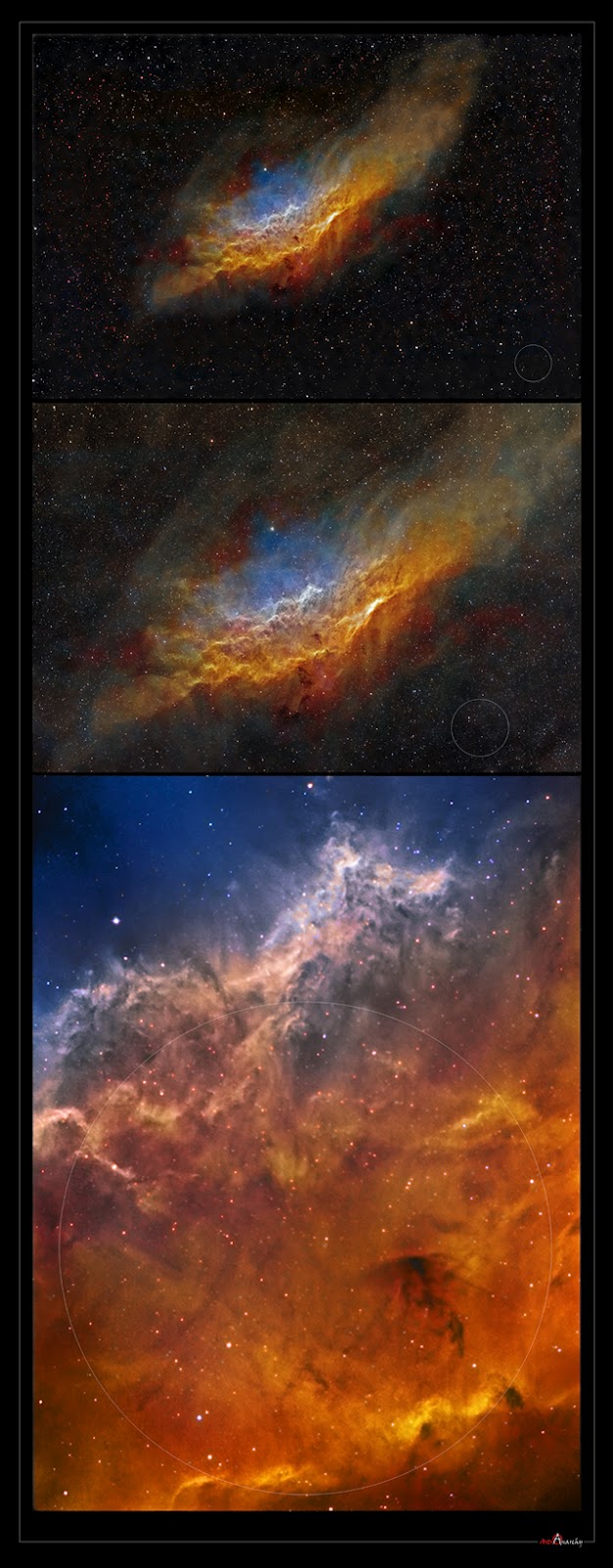COPYRIGHT, PLEASE NOTE
All the material on this website is copyrighted to J-P Metsavainio, if not otherwise stated. Any content on this website may not be reproduced without the author’s permission.
BUY A MUSEUM QUALITY POSTER
BUY A POSTER:https://astroanarchy.zenfolio.com/
Wednesday, February 29, 2012
Siemis 147, the scale in a sky
"How much your telescope magnified?"
This HST-palette zoom in series has a "Moon circle" as a scale, to demonstrate the angular scale in a sky.
People generally seems to have a false idea, that high magnification is needed to capture deep space images.
In fact, many times it's quite contrary, targets are so large, that I have difficulties to fit them in my instruments field of view. Sample image here, Simeis 147, is shot with 200mm camera optics and it barely fits in image area.
Much more important, than magnification, is the light gathering power = aperture.
High magnification is needed for planetary imaging and some small angular size objects, like planetary nebulae and small galaxies.
I have placed a white circle in image series below, to show the angular size of the full Moon in the sky.
Moon has an apparent diameter ~30 arc minutes, that's equal to 0,5 degrees.
At first panoramic image at the Left three main objects are seen. At bottom lays IC 405 and IC 410, at top Siemis 147 (Sharpless 240, Sh2-240)
Original images used for the zoom in series, with technical data
Simeis 147:
IC 405 & 410:
A large collection of my scale studies can be found here:
Labels:
research and development
Friday, February 24, 2012
Astro Anarchy gets published, again...
SPACE PICTURE OF THE WEEK, second in row...
National Geographic published my picture of Simeis 147, the "Expansive Nebula", as one of the Space pictures of the Week, Today 24.02. Actually this is a second one in two weeks, I'm kind of shocked...
Here is the link to a National Georaphic news:
Simeis 147, Sharpless 240 (Sh2-240)
In constellation Taurus
Image is in mapped colors, from the emission of ionized elements, R=Sulfur, G=Hydrogen and B=Oxygen.
Original blog post for this image, with technical details, can be seen here:
A closeup
Labels:
publications
Saturday, February 18, 2012
Astro Anarchy gets published
SPACE PICTURE OF THE WEEK
National Geographic published my picture of Ced 214, the "Cosmic Curiosity", as one of the Space pictures of the Week, yesterday 17.02.
Here is the link to a National Georaphic news:
http://news.nationalgeographic.com/news/2012/02/pictures/120217-best-space-pictures-183-sun-saturn-moons-science/#/space183-question-mark-nebula_48869_600x450.jpg
Original blog post for this image, with technical details, can be seen here:
Labels:
publications
Friday, February 17, 2012
The California Nebula, NGC 1499, with some new data
I shot about 5h new H-a data for the NGC 1499 in this Autumn, 2011, with Canon EF 200mm f1.8, full open, and a QHY9 cooled astronomical camera. All the exposures, I have taken for this object bettween years 2008-2011, are now used. Total exposure time is over 26h together for all three channels, Ionized Sulfur, Hydrogen and Oxygen. Two camera lenses was used to capture the data, a Tokina AT 300mm f2.8 and a Canon EF 200mm f1.8, both was used at full aperture. An extra detail, at bright central area, is shot with a longer focal length instrument, Meade LX200 GPS 12" at f5. Exposure time for central detail was about 10h, at top of the total 26h exposure time.
NGC 1499, in Perseus
Ra 04h 03m 18s Dec +36° 25′ 18″
Natural color composition from the emission of ionized elements, R=80%Hydrogen+20%Sulfur, G=100%Oxygen and B=85%Oxygen+15%Hydrogen to compensate otherwise missing H-beta emission. This composition is very close to a visual spectrum.
The California Nebula is an emission area located in constellation Perseus. It appears to resemble outlines of State of California on long exposure photographs, like this one. It has a very low surface brightness and it's very difficult to observe visually. Distance from my home town Oulu, Finland, is about 1000 light years.
this image spans about five degrees. The Wikipedia article states, that the angular size is about 2,5 degrees (Five full Moons side by side) but as can be seen in this image, the actual size, with a dim outer parts, is much large.
this image spans about five degrees. The Wikipedia article states, that the angular size is about 2,5 degrees (Five full Moons side by side) but as can be seen in this image, the actual size, with a dim outer parts, is much large.
HST-palette, (HST=Hubble Space Telescope) from the emission of ionized elements,
R=Sulfur, G=Hydrogen and B=Oxygen.
A study about the apparent scale in a sky
This is a large object, note, the size of the Moon is marked, as a scale, in all of the images above.
3D-studies
Experimental 3D-studies of NGC1499 can be found in my portfolio, in different formats.
Please, have a look here:
Subscribe to:
Comments (Atom)

















